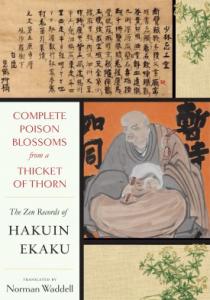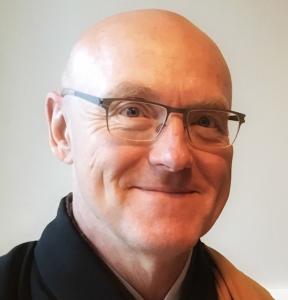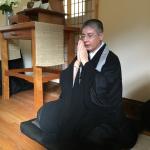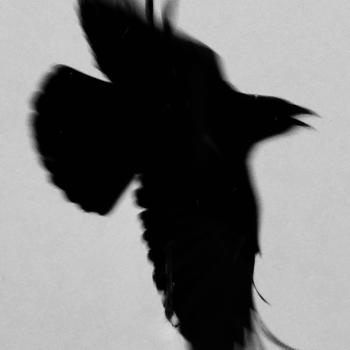
Recently, I interviewed a prospective student for the Vine of Obstacles: Online Support for Zen Training. He’d spend about a decade doing center-based Zen study with a nonkoan teacher, and another decade on his own doing Sōtō home-based practice. In our conversation, I mentioned how I’m in both the lineage streams of Dōgen (through Katagiri Roshi,1928 – 1990) and Hakuin (through Dōkutan Sōsan Rōshi, 1840 – 1917, Dai-un Sōgagku Rōshi, 1871 – 1961, and James Myōun Ford Rōshi, 1948 – ).
“Ah,” he hesitated, “who was this ‘Hakuin’ guy? Don’t think I ever heard of him.”
Hakuin is an enormously important figure in our Zen tradition, and his work deserves much more attention than it gets. So in this post, I’ll tell you a bit about him, laud Complete Poison Blossoms, an important recent translation of his work (see above cover image), and briefly share some thoughts about why Hakuin is so important for us today.
By the way, I’m planning to focus this Wild Fox Zen blog on Hakuin’s teaching, and especially Complete Poison Blossoms, through all of 2018, so if you’re a regular reader, you also might want to get the text. There is an earlier version of Poison Blossoms, also translated by Waddell, that contains about half the material in Complete Poison Blossoms. My recommendation, though, is not to hold back – buy the whole thing! It’s the only Zen study text you’ll need for at least a decade! So in that, it’s a bargain.
Emphasizing the importance of Complete Poison Blossoms, Waddell quotes Iida Tōin (1863–1937), another heretic with training in both Sōtō and Rinzai traditions:
“Anyone who wants to understand Master Hakuin must read Poison Blossoms from a Thicket of Thorn. Half-baked Zen teachers who disparage Hakuin without having read it are like blind men groping at an elephant. . . . Although as the title indicates it contains much material that is extremely difficult to grasp, how can anyone claiming to be a descendant of Hakuin really know him unless he has read this work? I have always kept my own copy close at hand. It gives me the feeling that I am living together with the old master.”
About Hakuin
Hakuin Ekaku (白隠 慧鶴, 1686 – 1768) and his eighty successors are often cited for being responsible for the revival of the Rinzai school. Hakuin was a central figure in the development of the modern kōan introspection method, including the Harada-Yasutani system, the most commonly practiced curriculum in the West today. Scholar and translator, Norman Waddell, has done us an enormous service through his numerous Hakuin translations, including the most recent Complete Poison Blossoms from a Thicket of Thorn: The Zen Records of Hakuin Ekaku, the work that I’ll turn to in a moment.
But who was this “Hakuin” guy? One of Hakuin’s most important successors, Tōrei, described Hakuin as lumbering like an ox and glaring like a tiger. Those images continue to come to mind as I study this great old teacher.
Hakuin was born to a middle-class family fairly close to Tokyo (but before it became Tokyo and when Kyoto was the center of the Rinzai Zen world) and became a monk at a young age. When he was nine, his mother had made the questionable parenting decision of taking him to a talk on the hell realms. This questionable decision was the sand in the oyster that led to the pearl of Hakuin’s Zen. At the time, however, the fragile young Hakuin was deeply impacted, tormented even, by the hell realm images and became a monk about five years later because he was still freaking out about being reborn in hell.
When he was twenty-two, following some years of rigorously throwing himself wholeheartedly in the mu kōan, Hakuin heard the sound of a distant temple bell, and had a significant kenshō. He met his heart teacher soon after that, Shōju Rōjin Roshi (1642–1721), and had several more important kenshō. After about ten years of pilgrimage, testing and refining his awakening with many different teachers, he eventually settled near his home village at Shōrinji, a small, dilapidated country temple. It was there at age forty-two that Hakuin had what he reported as his definitive awakening while reading the Lotus Sutra.
Here’s how Waddell describes it in Wild Ivy: The Spiritual Autobiography of Zen Master Hakuin:
“As Hakuin read, the sound of a cricket churring at the foundation stones of the temple reached his ears; at that instant, he crossed the threshold into great enlightenment. The accumulated doubts and uncertainties of forty years suddenly ceased to exist. The reason why the Lotus Sutra was regarded as supreme among all the Buddha’s preachings was revealed to him ‘with blinding clarity.’ He found teardrops ‘cascading down his face like strings of beads—they poured out like beans from a ruptured sack.’”
In Hakuin’s first decade after this awakening, he concentrated his bodhisattva vow energy toward the awakening of the small group of monks that gathered at Shōrinji. In the following three decades, Hakuin became an 18th Century Zen rock star, travelling and teaching widely. He was invited to explicate many texts, including the Blue Cliff Record, Lotus Sutra, Diamond Sutra, Dahui’s Arsenal, Gudō’s Lingering Radiance, and many more. Hundreds of practitioners attended these events and in some cases Hakuin’s introductory comments and verses for the occasions have been preserved and are included in Complete Poison Blossoms.
Hakuin regularly refers to the twenty-four Zen lineages transmitted to Japan, beginning in the 13th Century. Almost all of them were Rinzai lineages. And yet in the decades following Hakuin, all but two Rinzai lineages came to an end – the Obaku line and the line passing through Hsu-t’ang (Xutang Zhiyu 虚堂智愚, Japanese, Kido Chigu, 1185–1269), Nampo Jōmyō (1235–1308), and eventually through Hakuin and Gasan Jito (1727–1797).
Complete Poison Blossoms from a Thicket of Thorn: The Zen Records of Hakuin Ekaku
Complete Poison Blossoms is an extraordinary accomplishment and an enormous contribution to Zen practice. Many thanks to Norman Waddell!
Hakuin himself was very much involved in collecting and editing Complete Poison Blossoms and the text was published when he was in his early 70’s. That gave him another decade to teach from his own collected works. Waddell generously provides annotations made by some of Hakuin’s key successors, including Tōrei. Waddell also explains almost all of Hakuin’s references, bringing us more fully into the rich textures of Hakuin’s buddhadharma and secular narratives.
Hakuin’s buddhadharma narrative reveals a master of enlightening discourse while secular narrative is also strikingly rich and shows Hakuin to be engaged not only with monks and nuns but with lay people from many walks of life.
A hidden theme that doesn’t get much attention is the community that sprang up around Hakuin. It isn’t clear from the text whether it was planned or not, but when Hakuin became popular, many practitioners came to Shōrinji to train, way too many to provide for. Instead of creating a large monastic institution, Hakuin seems to have done what he could to provide simple accommodations at Shōrinji, but then sent small groups of practitioners into the local community to find food and lodging. According to Hakuin’s reports, they managed in bitter cold, living in whatever they could find, including abandoned shrines, surviving through begging and too often with very little food.
This decentralized model, catering to only the most stalwart practitioners, seems to have been a central ingredient to Hakuin’s success as a teacher.
Complete Poison Blossoms itself is equally decentralized and diverse, including, according to Waddell, “… instructions delivered on various occasions; formal and informal talks; verse and prose comments on koans; cautions on training addressed to individual students; remarks uttered at anniversaries, funeral services, and other temple observances; essays and explanations of terms from Buddhist scripture; letters, prefaces, and epilogues; painting inscriptions, a great many religious verses, and extended commentaries on the Heart Sutra and Tung-shan’s Five Ranks.”
Why Study Hakuin?
Primarily for the depth, breadth, and clarity of this message. How so?
In Complete Poison Blossoms, “78. Instructions to the Assembly at the Opening of a Lecture Meeting on the Lotus Sutra,” Hakuin wrote,
“Anyone who seeks to master the Buddha’s Way/Must begin by attaining a kenshō of total clarity.”
This is hardly the only time the primacy of kenshō for those who seek mastery of the buddhadharma is emphasized. In addition, the ongoing practice based on kenshō is a regular refrain in this and other Hakuin texts.
“Bodhisattvas of superior capacity,” Hakuin writes, “dwell in the dusty realm of differentiation, constantly carrying out their practice amid an infinite variety of distinctions.”
And he doesn’t just preach it, he practices it, and isn’t shy about sharing his own ongoing work. Writing about the Five Ranks, for example, he says, “But for more than thirty years … whether I was active or at rest, I was unable to feel truly at ease. Today, I have for the first time penetrated its secret mysteries completely. In comparison to this, everything I previously understood was no more than a shadow or an echo.”
He says similar things about a bunch of the kōan he comments on, adding an immanent subtlety that’s seldom encountered. So if even as an outstanding master, a Zen rock star, such as Hakuin continued doing the finely-drawn work of cultivating verification throughout his life, then those half-baked potatoes like me teaching Zen today should also be so inclined.
Finally, Hakuin connects kenshō and ongoing cultivation with the bodhisattva vow to carry all beings across in the most palpable and powerful way. For forty years after his definitive awakening, he worked tirelessly to help others realize the same heart-mind as the Buddha.
If you’re interested in such stuff, stay tuned.
Dōshō Port began practicing Zen in 1977 and now co-teaches with his wife, Tetsugan Zummach Sensei, with the Vine of Obstacles: Online Support for Zen Training, an internet-based Zen community. Dōshō received dharma transmission from Dainin Katagiri Rōshi and inka shōmei from James Myōun Ford Rōshi in the Harada-Yasutani lineage. Dōshō’s translation and commentary on The Record of Empty Hall: One Hundred Classic Koans, is now available (Shambhala). He is also the author of Keep Me In Your Heart a While: The Haunting Zen of Dainin Katagiri. Click here to support the teaching practice of Tetsugan Sensei and Dōshō Rōshi.













